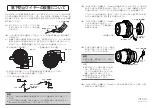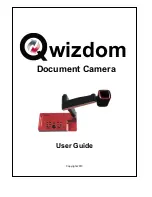
4.4 Post Analysis
4.4.1 Loading a Session
Click on a session thumbnail in the Session Browser, or navigate from the Drop-down Menu to File>Open
Session and browse to “session folder”>TestData. The application title bar will display the session name to
indicate that it is currently loaded. At this point, you can press the play button underneath the video window to
begin playback of your selected video. Toggle the Realtime Settings and Image Settings to adjust the gradient
audio overlay. Lowering the dynamic range will clean up the gradient and help to immediately pinpoint
significant sound sources. (
4.4.2. Processing a Selection
There are two options in FINDr for further analytic processing of recorded movies; they can both be found in
the “Process Selection” window, underneath the spectrogram.
4.4.2.1 Creating an Audio Image
This takes a user-selected time and frequency range from a recorded session and creates a static image from
data present in the range. The background image is the first frame of video in your selection and the color
gradient in the image is an integration of all present frequencies averaged over time.
To create an Audio Image, select a time/frequency range in the Spectrogram Window (
), and then click
Compute Audio Image, or navigate in the Menu Bar to Analyze->Compute Audio Image.
Audio Images can be saved as a jpeg image by navigating to Drop-down Menu>Analyze>Save Image.
4.4.2.2 Creating an Audio Movie
An Audio Movie computes the Acoustic Image for every block of audio, advancing by 32 samples at a time.
This creates a granular frame-by-frame movie of a user-selected time/frequency range from the Spectrogram
Window. Playing an Audio Movie can reveal the path of sound to the Camera and reflections in the scene.
To create an Audio Movie, select a time/frequency range in the Spectrogram Window (
), and then click
Compute Audio Movie, or navigate in the Menu Bar to Analyze->Compute Audio Movie.
Once processed, a timeline bar and a
“Play Movie” button will appear under the button. Click on Play Movie to
start playback; Play Movie is then replaced with “Stop Movie” until playback is stopped. Drag the slider next to
the play/stop button to find a specific frame in the movie. In the Spectrogram Window, a red line will appear in
the selected range box, and with the Video Window, indicates the currently displayed frame in time. The Video
Window is synced to position of the red line and displays the Audio Movie frame-by-frame. During playback,
the frequency selection controls should not be altered and doing so will interfere with the computed Acoustic
Image.
4.4.3 Exporting Results
Audio Images can be saved as a JPEG image to be included in reports. Navigate to the Drop-down Menu
Analyze->Save Image, and choose a location for the output file. The image includes the title of the session, the
video with Acoustic Image, and a legend to document the SPL-Color Gradient relationship selected for the
image.

































